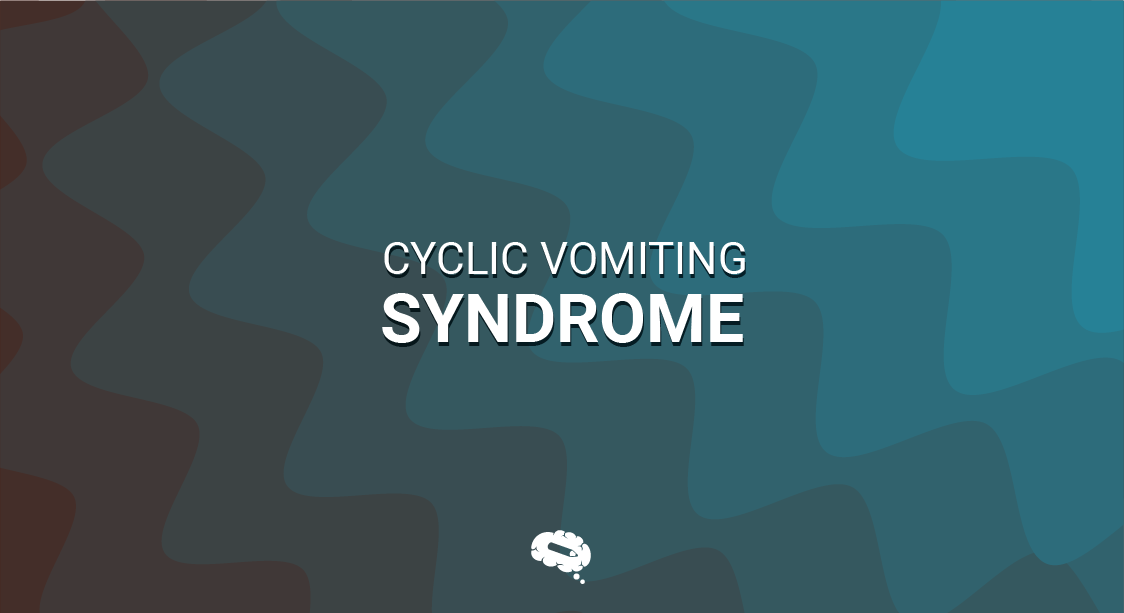Do you know what CVS is? Cyclic Vomiting Syndrome (CVS) is a perplexing condition characterized by recurrent episodes of severe vomiting that occur in cycles, with periods of normal health in between. While it mainly affects children, CVS can continue into adulthood, with episodes lasting from hours to days. Although relatively rare, impacting about 1 in 33,000 children, CVS can significantly disrupt the quality of life, leading to risks like dehydration and nutritional deficiencies. Understanding and recognizing CVS is crucial for early diagnosis and effective management, distinguishing it from other gastrointestinal disorders, and ensuring appropriate care.
What is Cyclic Vomiting Syndrome?
Cyclic Vomiting Syndrome (CVS) is a disorder characterized by recurrent, severe episodes of vomiting that occur in cycles, with symptom-free periods in between. Unlike acute gastroenteritis or food poisoning, CVS episodes are not necessarily linked to an infection or specific dietary triggers.
The primary symptoms of CVS include intense, repetitive vomiting that can last from hours to days, often accompanied by nausea, abdominal pain, and sometimes diarrhea. Patients may also experience fatigue and dehydration due to the frequent vomiting. One key characteristic of CVS is the predictability of the vomiting cycles, which may occur at regular intervals or be triggered by specific factors, such as stress or certain foods.
How CVS Differs from Other Conditions
CVS can be challenging to differentiate from other vomiting-related disorders, such as gastroesophageal reflux disease (GERD) or cyclic nausea and vomiting of childhood (CNV). Unlike GERD, which involves chronic acid reflux, CVS is marked by episodic vomiting with well-defined symptom-free intervals. Unlike CNV, which generally occurs in young children and often resolves with age, CVS can persist into adulthood and is not limited to a specific age group.
Accurate diagnosis of CVS is crucial because it helps distinguish it from other conditions with similar symptoms and ensures appropriate management. Misdiagnosis can lead to unnecessary treatments or delays in receiving effective care. Understanding CVS allows for targeted therapies and interventions that can significantly improve the patient’s quality of life and prevent complications associated with frequent vomiting.
Causes and Risk Factors
The exact cause of Cyclic Vomiting Syndrome (CVS) remains unclear, but several factors are believed to contribute to its development. While the condition is not fully understood, it is often considered a multifactorial disorder involving genetic, environmental, and physiological factors.
Possible Causes
Genetic Factors: There is some evidence suggesting that genetic predisposition may play a role in CVS. Families with a history of CVS or similar conditions, such as migraines or gastrointestinal disorders, might have a higher likelihood of developing the syndrome. While specific genetic markers have not been identified, a hereditary component could be influencing the susceptibility to CVS.
Environmental Triggers: Environmental factors can trigger CVS episodes in susceptible individuals. Common triggers include stress, certain foods (like chocolate or cheese), infections, or changes in sleep patterns. Environmental factors such as exposure to strong smells or emotional stressors have also been noted as potential precipitants for CVS episodes.
Who is at Risk?
Age Groups Commonly Affected: CVS can affect individuals of all ages, but it is most commonly diagnosed in children, particularly those between the ages of 3 and 7. The condition often starts in childhood, though it can persist into adolescence and adulthood. Some adults also develop CVS later in life, making it important to consider the syndrome across all age groups.
Lifestyle and Health Factors Contributing to CVS: Several lifestyle and health factors can contribute to the risk of developing CVS. Individuals with a history of migraines or other chronic illnesses, such as asthma or irritable bowel syndrome, may be at increased risk. Stressful life events, inconsistent sleep patterns, and dietary habits can also influence the onset and frequency of CVS episodes.
Symptoms and Diagnosis
Common Symptoms
Intense Vomiting: Patients experience severe bouts of vomiting that can be frequent and intense. The vomiting is often uncontrollable and may be accompanied by retching or dry heaving.
Nausea: Patients often feel nauseous even between vomiting episodes, contributing to overall discomfort. The level of nausea can vary but is typically severe during episodes.
Abdominal Pain: Pain is usually located in the abdominal region and can be crampy or colicky, and can range from mild to intense, often worsening during vomiting episodes.
Diarrhea: Some patients may experience diarrhea alongside vomiting.
Fatigue: Patients often feel extremely tired and weak due to the physical strain of frequent vomiting. This can significantly affect daily activities and overall quality of life.
Dehydration: Due to frequent vomiting, patients are at high risk of dehydration, which may manifest as dry mouth, dark urine, and dizziness. Rehydration with fluids and electrolytes is crucial to manage this symptom.
Malaise: Patients may experience a general sense of malaise or unease, contributing to their overall feeling of illness and discomfort. This general feeling of being unwell can persist even between vomiting episodes.
Diagnostic Process
Tests and Assessments Used: Diagnosing CVS involves a comprehensive evaluation to rule out other potential causes of recurrent vomiting. There is no specific test for CVS, so the diagnostic process typically includes a combination of medical history review, physical examination, and laboratory tests. Common assessments may include blood tests to check for dehydration or underlying conditions, imaging studies such as abdominal ultrasound or CT scans to exclude structural abnormalities, and endoscopic procedures to evaluate the gastrointestinal tract.
Criteria for Diagnosis: Diagnosing CVS is largely clinical, focusing on recurrent vomiting episodes with symptom-free intervals, and ruling out identifiable causes like infections or structural abnormalities. It involves excluding other gastrointestinal or systemic disorders. A thorough evaluation by a healthcare provider, such as a gastroenterologist, is crucial for confirming the diagnosis and developing an effective treatment plan, ensuring targeted management to improve quality of life.
Treatment and Management
Medical Treatments
Common Medications Prescribed:
Antiemetics: Medications to control nausea and vomiting during episodes.
Prophylactic Medications: Drugs may be used to prevent the occurrence of CVS episodes. These medications can help stabilize the gastrointestinal system and reduce the frequency of episodes.
Acid-Reducing Medications: In some cases, proton pump inhibitors (PPIs) or H2 receptor antagonists may be prescribed to manage associated abdominal pain or reflux.
Alternative Therapies:
Herbal Remedies: Some patients find relief with herbal treatments such as ginger or peppermint, which can help reduce nausea and improve digestive comfort.
Acupuncture: This traditional Chinese medicine technique may offer symptom relief by targeting specific points associated with nausea and vomiting.
Biofeedback: This technique can help patients learn to control physiological functions and manage stress, potentially reducing the frequency and severity of episodes.
Recently, adult CVS has been reconsidered as a neurogenic disorder, where different underlying genetic and environmental factors influence the activity of neural circuits responsible for the condition. This new perspective draws parallels between adult CVS and other neurological disorders like chronic migraine, epilepsy, and panic disorder, suggesting that treatments effective for these conditions might also help manage CVS. The review aims to achieve three main objectives: to establish a detailed framework for understanding the causes of adult CVS, to identify new potential treatments based on this framework, and to outline future research needs to advance the understanding and treatment of CVS. Read more about The Cyclic Vomiting Syndrome Treatments at this link.
Lifestyle and Home Remedies
Avoid Known Triggers: Identify and avoid foods that may trigger vomiting episodes. Common triggers include chocolate, caffeine, fatty foods, and spicy foods. Keeping a food diary can help in recognizing patterns.
Eat Small, Frequent Meals: Consuming smaller, more frequent meals instead of larger ones can help prevent overstimulation of the gastrointestinal system, reducing the risk of triggering symptoms.
Stay Hydrated: Ensuring proper hydration is essential, especially during and after vomiting episodes. Drink clear fluids such as water, broth, or electrolyte solutions to replenish lost fluids and prevent dehydration.
Bland Foods: Opt for bland, easy-to-digest foods such as plain crackers, bananas, or rice during recovery periods to minimize gastrointestinal discomfort.
Stress Management Techniques:
Relaxation Exercises: Incorporate relaxation techniques such as deep breathing exercises, progressive muscle relaxation, or guided imagery to reduce stress and anxiety, which can trigger CVS episodes.
Meditation and Mindfulness: Practicing meditation or mindfulness can help manage stress and improve emotional well-being. Regular mindfulness sessions can help individuals remain calm and focused.
Yoga: Engaging in gentle yoga practices can promote relaxation and improve overall stress management. Yoga also helps in managing physical symptoms and improving digestive health.
Cognitive Behavioral Therapy (CBT): CBT can be beneficial for addressing stress, anxiety, and coping strategies. Working with a therapist trained in CBT can help individuals develop effective strategies to manage stress and reduce the frequency of CVS episodes.
Managing Life with Cyclic Vomiting Syndrome (CVS)
Living with CVS
Day-to-Day Coping Strategies:
Routine Management: Establishing a consistent daily routine can help manage CVS symptoms. Regular sleep patterns, meal times, and stress management practices contribute to overall stability.
Symptom Tracking: Keeping a symptom diary can help identify triggers and patterns. This information is valuable for adjusting lifestyle and dietary habits to minimize the risk of episodes.
Medication Adherence: Following prescribed treatments and medications as directed by healthcare professionals is crucial for managing symptoms and preventing episodes.
Emergency Preparedness: Preparing for vomiting episodes by having a plan in place, such as carrying necessary medications and maintaining hydration supplies, can help reduce stress during an episode.
Support Networks and Resources:
Healthcare Providers: Regular consultations with healthcare professionals, including gastroenterologists and dietitians, can provide ongoing support and adjustments to treatment plans.
Support Groups: Joining support groups, either in-person or online, can offer valuable connections with others who understand the challenges of living with CVS. These groups can provide practical advice, emotional support, and a sense of community.
Educational Resources: Accessing educational materials about CVS, including pamphlets, books, and reliable websites, can help individuals and families better understand the condition and its management.
Support for Families and Friends
Understanding and Education: Learning about CVS and its impacts can help loved ones provide informed support. Understanding the nature of the episodes and the challenges faced can lead to more effective assistance.
Offering Practical Help: Families and friends can assist with daily tasks during an episode, such as preparing meals, managing medications, or providing transportation to medical appointments.
Emotional Support: Providing a listening ear, offering encouragement, and being patient during challenging times is essential for emotional well-being. Encouragement and positive reinforcement can help individuals cope better with the condition.
Empathy: Demonstrating empathy and acknowledging the difficulties of living with CVS can foster a supportive environment. Recognizing the impact of the condition on daily life and emotional health is crucial.
Open Communication: Maintaining open lines of communication between the individual with CVS and their loved ones ensures that needs and concerns are addressed effectively. This approach helps build a strong support system that contributes to better management of the condition.
Exclusive Scientific Content, Created By Scientists
Mind the Graph significantly aids scientists by offering exclusive scientific content specifically crafted by experts in the field. This tailored content ensures that the platform provides high-quality, relevant visual resources that accurately represent complex scientific concepts. By leveraging this expert-created material, scientists can produce visually appealing and scientifically accurate infographics and diagrams that enhance the clarity and impact of their research presentations. The use of such specialized content helps streamline the visualization process, allowing researchers to focus on their scientific work while effectively communicating their findings to a broader audience. Sign up for free!

Subscribe to our newsletter
Exclusive high quality content about effective visual
communication in science.





